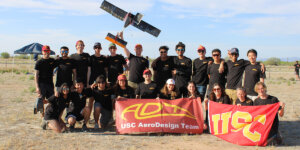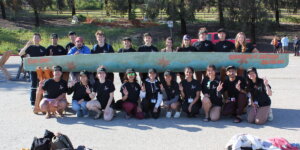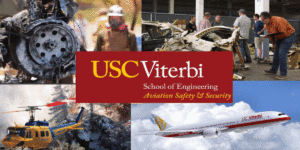
AeroDesign Team members at the 2016 Critical Design Review. Photo/AeroDesign Team
One-by-one, the 14 captains of USC’s AeroDesign Team stood in front of a room filled with aerospace industry experts and presented the design of this year’s remote controlled model aircraft.
Since September, the team has been working nonstop to build a plane that meets the requirements of the annual American Institute of Aeronautics and Astronautics (AIAA)“Design Build Fly” competition. After months of testing, they narrowed in on a design to present to the attendees of their Critical Design Review at the end of January, which included industry representatives from companies like Lockheed Martin, Boeing and Northrop Grumman, as well as USC alumni and former team members.
Each year, the AIAA comes up with new missions that the competing university student teams must complete at the event in April. This year, the aircraft must fold up to fit inside a protective tube, as well as fly with a payload of hockey pucks. The less the plane and tube weigh, smaller the tube diameter, more hockey pucks the plane can carry and more laps it can complete, the higher the score.
“As much that it’s crunch time and there’s lots of work to do, our results have been encouraging,” said Aaron VanLandingham, the team’s project manager and senior aerospace engineering student.
After giving a description of the competition requirements, VanLandingham passed the floor to the captains of the various component teams, each of which is responsible for a different aspect of the plane. They went into detail on the considerations and restrictions that dictated their design choices, taking questions and feedback from the attendees.
The design of the plane’s tail and the technique the students were using to hand launch the aircraft, a requirement of this year’s competition that has been causing difficulty during test-flights, provoked a lively discussion among the guests.
“I think the primary issue is in getting a consistent throw,” said Charles Radovich, the team’s academic advisor and senior lecturer in the AME department. “If they can throw without imparting a side force, or moment, then we can isolate the flight characteristics and determine if it is in fact the tail, or if the plane just can’t recover from an errant throw.”
A “hand launch” requires a student to throw the plane like a dart, achieving a fast enough acceleration for the plane to take off. Because of the plane’s small size, there is almost no room for error at the gripping location, as just a one or two centimeter shift could result in failure.
“The hand launch is a tricky requirement that adds to an already complex year requiring us to make a plane that fits compactly in a tube,” VanLandingham said.
To keep the tube diameter to a minimum, they designed complex mechanisms that allow the plane to fold up as compactly as possible, while also ensuring it will be stable enough to fly while carrying hockey pucks. This was no easy feat.
Passing around several prototypes of their homemade moveable joints, the team described how the wings and tail will move, lock into place before flights and withstand lift and drag forces. This “transformer” ability is what inspired the name of the aircraft.
“We always try to pick a plane name that has an ‘SC’ in it and occasionally try to pick a name related to the contest rules,” VanLandingham said. “The name is particularly fitting because the Transformer StarSCream turns into a fighter jet.”
StarSCream’s abilities will be put to the test April 20-23, at this year’s “Design Build Fly” competition hosted by Raytheon Missile Systems in Tucson, Ariz.
“Each year has its own challenges that push the team to develop creative and practical solutions. It is why we like this particular contest so much and what makes working with the team such a rewarding experience,” VanLandingham said.
Published on February 16th, 2017
Last updated on November 7th, 2017












